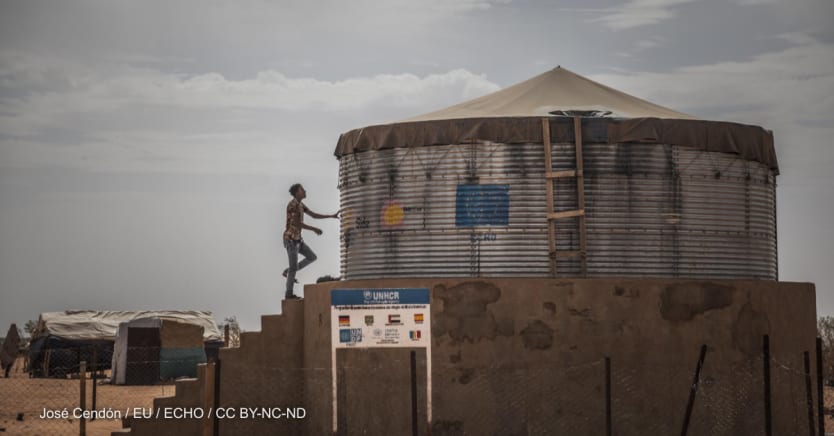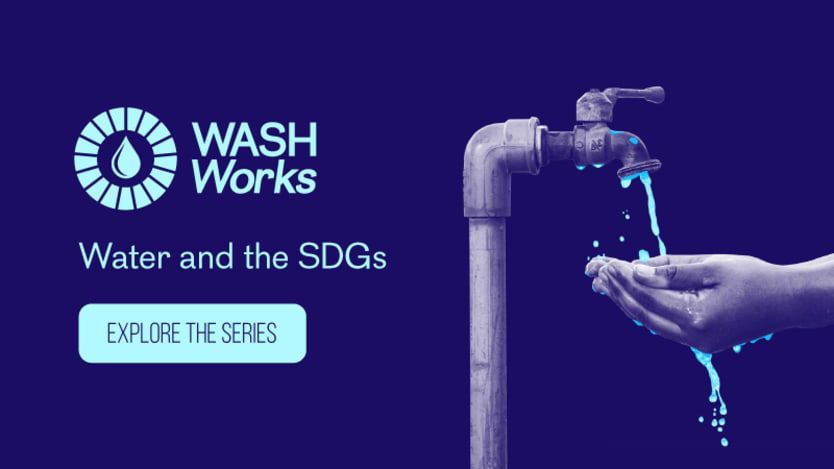
Factoring in the WASH needs of people living with disabilities within humanitarian settings is not systematic and needs to be, according to Angelica Fleischer, a global WASH specialist with Humanity & Inclusion. The current global focus on intersectionality presents a “unique opportunity” to push this forward, she said.
According to the United Nations Office for the Coordination of Humanitarian Affairs, there are around 41 million people living with disabilities who are affected by crises. Yet WASH facilities within humanitarian settings may not be designed from the outset with accessibility in mind, Fleischer explained.
“There's just such a huge workload for humanitarian actors in an emergency and I think that considering accessibility and inclusion for people with disabilities sometimes gets pushed to the bottom of the list,” Fleischer said. This means the construction of toilets and hand-washing facilities in a camp setting may not be accessible for wheelchair users and could be lacking assistive devices such as a ramp or handrails.
“If [a facility is] located too far for them to access in the time that they need it, then they may resort to alternatives, such as open defecation or inappropriate disposal of feces,” she said. This can endanger the health of the individual in question, but also others around them should the environment and water sources become contaminated.
According to the World Health Organization, diarrheal diseases are the second major cause of death among children under 5, and are more prevalent in environments lacking adequate sanitation, hygiene, and safe water.
People with disabilities may also require more water for bathing and laundry, Fleischer added. “That creates a significant burden for a person with disabilities and or their caregivers to access that water,” she said, adding that if the water source is difficult to operate or too far they may turn to contaminated sources.
The Convention on the Rights of Persons with Disabilities states that all signatories must “take all necessary measures to ensure the protection and safety of persons with disabilities in situations of risk, including armed conflicts, humanitarian emergencies and natural hazards.”
The additional challenges such as a lack of access to water, sanitation, and hygiene that people living with disabilities face in a humanitarian context need addressing and it’s time to take action, Fleischer said.
“In an emergency … considering accessibility and inclusion for people with disabilities sometimes gets pushed to the bottom of the list.”
— Angelica Fleischer, global WASH specialist, Humanity & InclusionShe called on WASH actors to implement the four practical recommendations in the Inter-Agency Standing Committee’s Guidelines on the Inclusion of Persons with Disabilities in Humanitarian Action. These include engaging people with disabilities to find out what WASH barriers they face in a humanitarian context, removing those barriers, empowering people with disabilities on their own rights, and disaggregating any data gathered by on disability to ensure better future planning.
“They seem simple on paper but sometimes when we try and translate them into practice, that's the challenge,” Fleischer said, adding that given the many cross-cutting priorities there are to factor in, it can be overwhelming. “That's where we're at today. We have all the knowledge and the models but translating that from the theory into practice is a challenge that every organization struggles with.”
To help with this, HI is integrating an accessibility checklist into all of its WASH programming that’s to be consulted every time a water point is rehabilitated or a latrine is built. “You go through a checklist of all the elements of accessibility, and you see where you are in relation to the ideal … and looking at the feasibility of universal design versus what we could achieve with reasonable accommodation.”
Fleischer also recommended training staff to identify the gaps in WASH activity design and engaging people living with disabilities as staff, community volunteers, and WASH committee members.
“I think everybody probably has these accessibility checklists or these audits in their toolbox of things to do and use, but it's not systematic and I think that's where we need to move to,” she added.
Visit the WASH Works series for more coverage on water, sanitation, and hygiene — and importantly, how WASH efforts intersect with other development challenges. You can join the conversation using the hashtag #WASHWorks.









